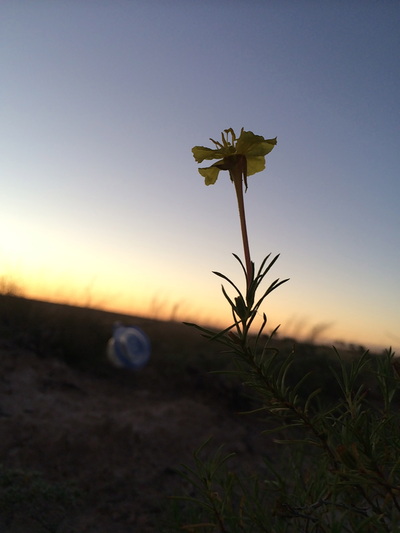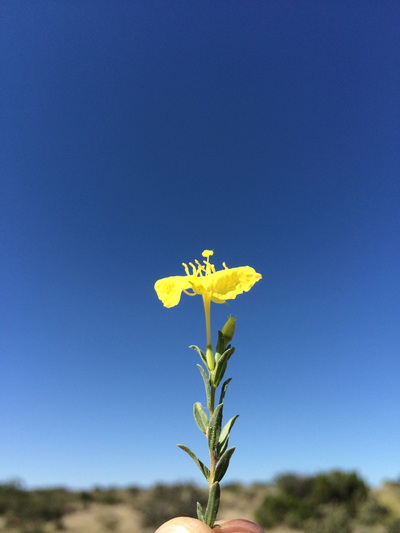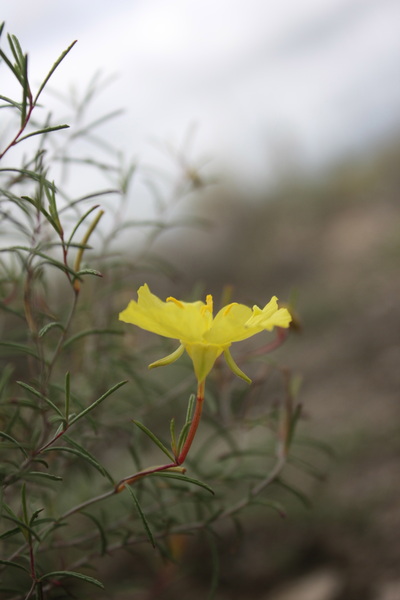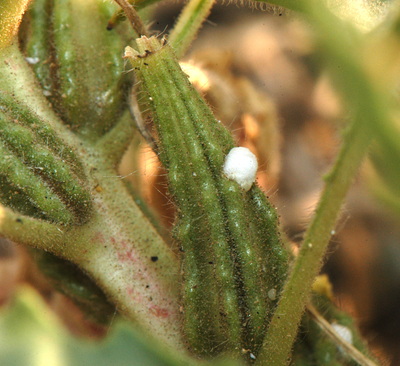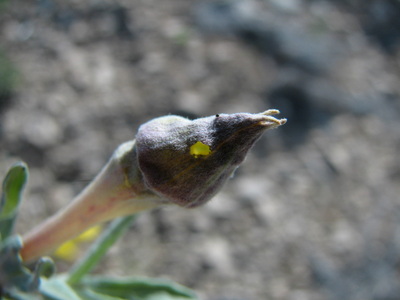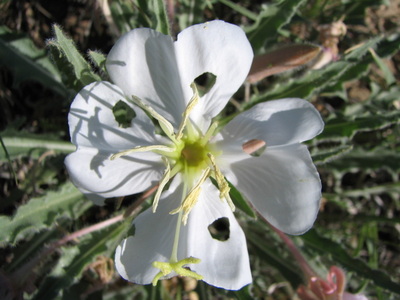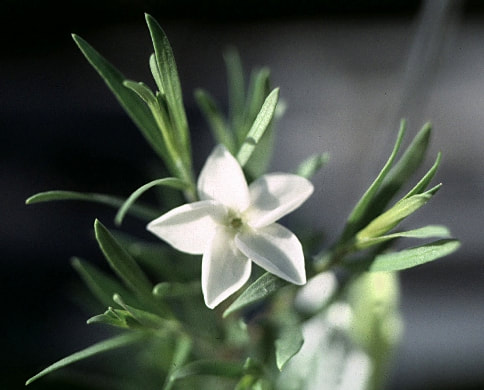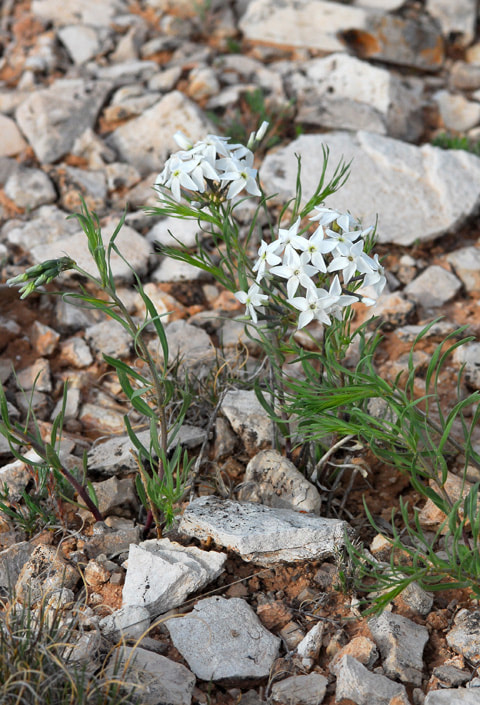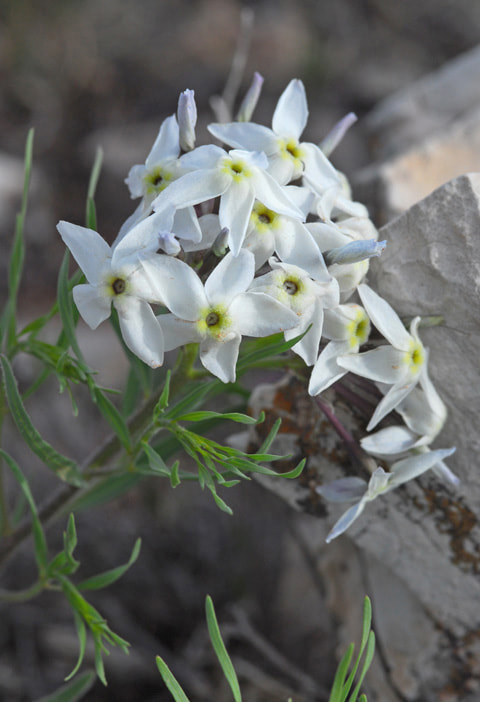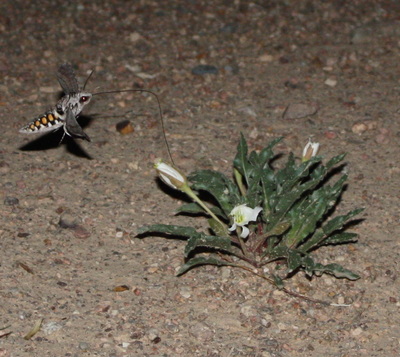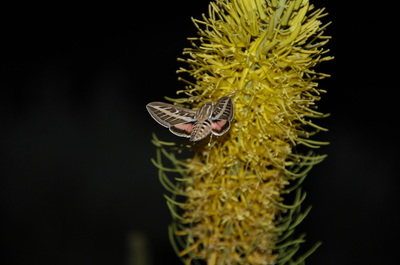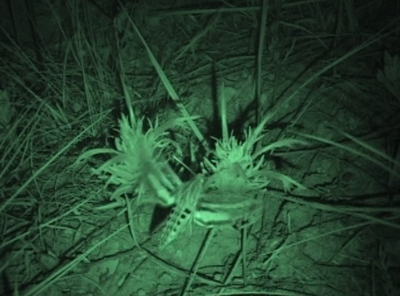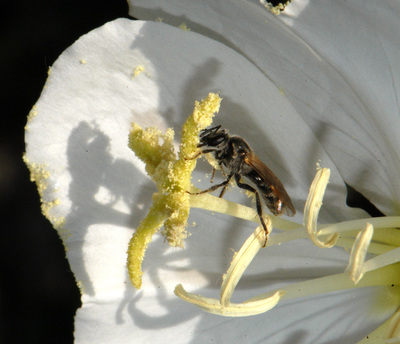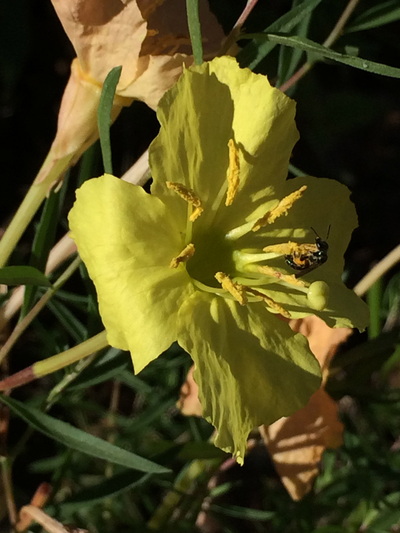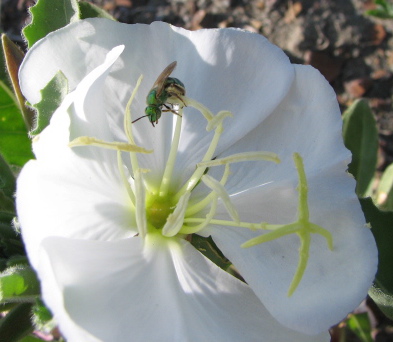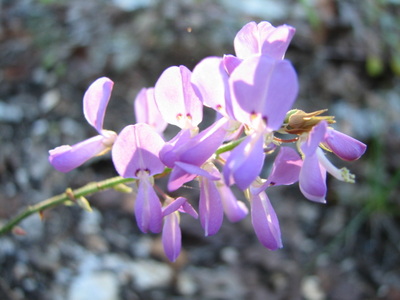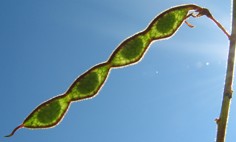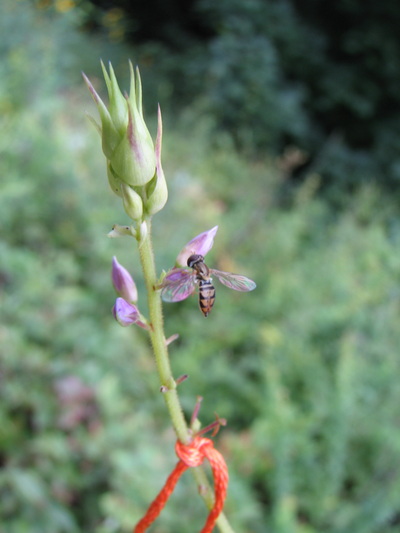
We commonly think of floral scent for its role in attracting pollinators, but it can also be a cue for floral and seed predators. This project integrates chemical ecology and comparative genomics to explore the impact of past selective pressures on current patterns of diversity in non-model organisms: evening primroses, hawkmoths, bees, and micromoths. In particular, we are investigating how chemically-mediated interactions between flowering plants, pollinators, and enemies affect diversification at the population, species, and higher taxonomic levels. Onagraceae (evening primrose family) is one of the most species-rich families of night-blooming plants in North America. Many Onagraceae, particularly species in tribe Onagreae, produce floral scent that likely dictates the primary biotic drivers impacting plant fitness, including legitimate pollinators (hawkmoths, bees) and floral and seed predators (Mompha moths). The same floral characteristics (color, shape, scent) that attract pollinators are also suspected to attract floral antagonists to host plants. Mompha is one such moth genus that specializes on Onagraceae. A thorough survey of these micromoths associated with Onagreae in western North America will result in a more accurate assessment of diversity in this group. Three dimensions of biodiversity will be integrated through studies of (1) floral trait variation, (2) its genetic basis, and (3) their roles in driving patterns of diversity in Onagreae and Mompha. The identification of “hot” and “cold” spots of selection will provide a test of the role of scent in the creation and maintenance of biodiversity across landscapes and time.
Participants: PI: Krissa Skogen, CO-PIs: Jeremie Fant (Chicago Botanic Garden), Norm Wickett (Chicago Botanic Garden); PI: Robert Raguso (Cornell University); PI: Rachel Levin (Amherst College). Postdocs: Tania Jogesh (Chicago Botanic Garden)and Rick Overson (Chicago Botanic Garden)
Collaborators: Terry Harrison (University of Illinois at Urbana-Champaign), Jean-Francois Landry (Agriculture & Agri-Food Canada, Eastern Cereal and Oilseed Research Centre), Mike Moore (Oberlin College), Warren Wagner (Smithsonian Institution), Kathleen Kay (University of California, Santa Cruz), and Sylvia Kelso (Colorado College).
Participants: PI: Krissa Skogen, CO-PIs: Jeremie Fant (Chicago Botanic Garden), Norm Wickett (Chicago Botanic Garden); PI: Robert Raguso (Cornell University); PI: Rachel Levin (Amherst College). Postdocs: Tania Jogesh (Chicago Botanic Garden)and Rick Overson (Chicago Botanic Garden)
Collaborators: Terry Harrison (University of Illinois at Urbana-Champaign), Jean-Francois Landry (Agriculture & Agri-Food Canada, Eastern Cereal and Oilseed Research Centre), Mike Moore (Oberlin College), Warren Wagner (Smithsonian Institution), Kathleen Kay (University of California, Santa Cruz), and Sylvia Kelso (Colorado College).
Anthropogenic Impacts on Pollination
Much work has documented the negative impacts of anthropogenic change (climate change, land-use change, nitrogen deposition, etc.) to plant reproduction and biodiversity loss more broadly. However, plant species with specialized biotic pollination systems such as hawkmoth pollination may be less vulnerable to specific threats.
Our newly-funded Amsonia Project is to assess the extent to which Tharp’s bluestar, A. tharpii, is impacted by land use change (habitat fragmentation and loss) associated with the recent expansion of the Permian Basin Pipeline under development in southeast New Mexico and adjacent west Texas. A. tharpii is endemic to this same region and it is suspected that plant reproduction and genetic diversity may be negatively impacted by oil and gas development. Importantly, this work will inform the federal endangered species listing process, as Tharp's bluestar is a top priority species in NM for listing under the Endangered Species Act. In addition, our research will help the Bureau of Land Management determine best practices for use in developing buffer zones and other management approaches to be incorporated into oil and gas leases that will limit impact on Tharp's bluestar and its pollinators.
Participants: PI: Krissa Skogen, CO-PIs: Jeremie Fant (Chicago Botanic Garden), Norm Wickett (Chicago Botanic Garden)
Postdoc to be hired Spring 2021
Funding: National Fish and Wildlife Foundation & U.S. Bureau of Land Management
The Amsonia Project builds on our work showing that hawkmoths are not deterred from visiting O. harringtonii plants growing in areas if moderate to high land-use change (Skogen et al. 2016). In addition, we have shown that pollination by hawkmoths facilitates long-distance dispersal of pollen and we found no genetic impact of land-use change that can be attributed to changes in pollinator movement (Skogen et al. 2019). This work suggests that some species may be buffered from the negative impacts of land-use change (genetic isolation) if long-distance dispersal is maintained.
Consequences of Hawkmoth vs. Bee Pollination:
Long distance gene flow, floral traits, & reproductive success
Long distance gene flow, floral traits, & reproductive success
Due to their ability to fly great distances, hawkmoths are expected to contribute to more long distance dispersal (pollen) events than bees, who tend to be central-place foragers. If this is the case, populations of plants pollinated by hawkmoths should experience greater gene flow, less genetic differentiation and higher outcrossing rates. In addition, if hawkmoths are not deterred from visiting plants growing in developed or fragmented landscapes, these same plant species may not experience the negative consequences of habitat fragmentation (greater isolation, reduced fitness, etc.) that their bee-pollinated counterparts may face.
Work conducted in my lab has provided robust tests of the role of pollinator functional group on plant mating dynamics, primarily using the genus Oenothera (Onagraceae) as a model system. First, detailed population-level assessments of pollinator visitation rates, pollen removal and deposition by hawkmoths and bees show that hawkmoths are the primary pollinators of the Colorado endemic Oenothera harringtonii (Onagraceae) (Skogen et al. 2016). Second, hawkmoth pollination of O. harringtonii results in high levels of gene flow and limited population differentiation (Skogen et al. 2019 ). Third, work by two MS students in my lab has explored differential mating patterns between hawkmoths and bees. Matt Rhodes (MS 2014) identified spatial genetic structure in a large population of O. harringtonii (Rhodes et al. 2014) and showed that hawkmoth pollination results in higher mate (pollen donor) diversity than does bee pollination (Rhodes et al. 2017). Emily Lewis (MS 2015) investigated two closely-related species within Oenothera at two spatial scales. She showed that the hawkmoth pollinated species experienced higher gene flow and less population differentiation than did the bee-pollinated species, and the differences were more pronounced at the landscape (60-440 km apart) than local (1.8-13 km apart) scale (Lewis et al., in prep). More recently, Ph.D. candidate Katie Wenzell has been exploring similar questions through comparisons of Castilleja sessiliflora and the C. purpurea species complex.
Work conducted in my lab has provided robust tests of the role of pollinator functional group on plant mating dynamics, primarily using the genus Oenothera (Onagraceae) as a model system. First, detailed population-level assessments of pollinator visitation rates, pollen removal and deposition by hawkmoths and bees show that hawkmoths are the primary pollinators of the Colorado endemic Oenothera harringtonii (Onagraceae) (Skogen et al. 2016). Second, hawkmoth pollination of O. harringtonii results in high levels of gene flow and limited population differentiation (Skogen et al. 2019 ). Third, work by two MS students in my lab has explored differential mating patterns between hawkmoths and bees. Matt Rhodes (MS 2014) identified spatial genetic structure in a large population of O. harringtonii (Rhodes et al. 2014) and showed that hawkmoth pollination results in higher mate (pollen donor) diversity than does bee pollination (Rhodes et al. 2017). Emily Lewis (MS 2015) investigated two closely-related species within Oenothera at two spatial scales. She showed that the hawkmoth pollinated species experienced higher gene flow and less population differentiation than did the bee-pollinated species, and the differences were more pronounced at the landscape (60-440 km apart) than local (1.8-13 km apart) scale (Lewis et al., in prep). More recently, Ph.D. candidate Katie Wenzell has been exploring similar questions through comparisons of Castilleja sessiliflora and the C. purpurea species complex.
Conservation Implications
Particularly important to me is combining basic and applied research whenever I can. I have a strong interest in addressing questions that can inform conservation decisions, specifically, the susceptibility of species with particular traits to the negative consequences of anthropogenic change.
My Ph.D. research focused on identifying the causes of decline in a nitrogen-fixing species, Desmodium cuspidatum (Fabaceae) and investigated the role that atmospheric nitrogen deposition may have played. I found that increased nitrogen availability can depress the competitive ability this unique functional group, which may be particularly susceptible to the negative consequences of anthropogenic inputs of nitrogen (Skogen et al. 2011).
Other conservation-focused work in my lab has investigated pollination success and the role of green roofs in urban biodiversity conservation (Ksiazek et al. 2014, Ksiazek et al. 2012) and the impact of drought on plant size and floral traits in O. harringtonii (K. Andrews, MS, 2019) which occurs in a region of the western U.S. predicted to experience increases in temperature and decreases in the amount and frequency of precipitation.
My Ph.D. research focused on identifying the causes of decline in a nitrogen-fixing species, Desmodium cuspidatum (Fabaceae) and investigated the role that atmospheric nitrogen deposition may have played. I found that increased nitrogen availability can depress the competitive ability this unique functional group, which may be particularly susceptible to the negative consequences of anthropogenic inputs of nitrogen (Skogen et al. 2011).
Other conservation-focused work in my lab has investigated pollination success and the role of green roofs in urban biodiversity conservation (Ksiazek et al. 2014, Ksiazek et al. 2012) and the impact of drought on plant size and floral traits in O. harringtonii (K. Andrews, MS, 2019) which occurs in a region of the western U.S. predicted to experience increases in temperature and decreases in the amount and frequency of precipitation.
